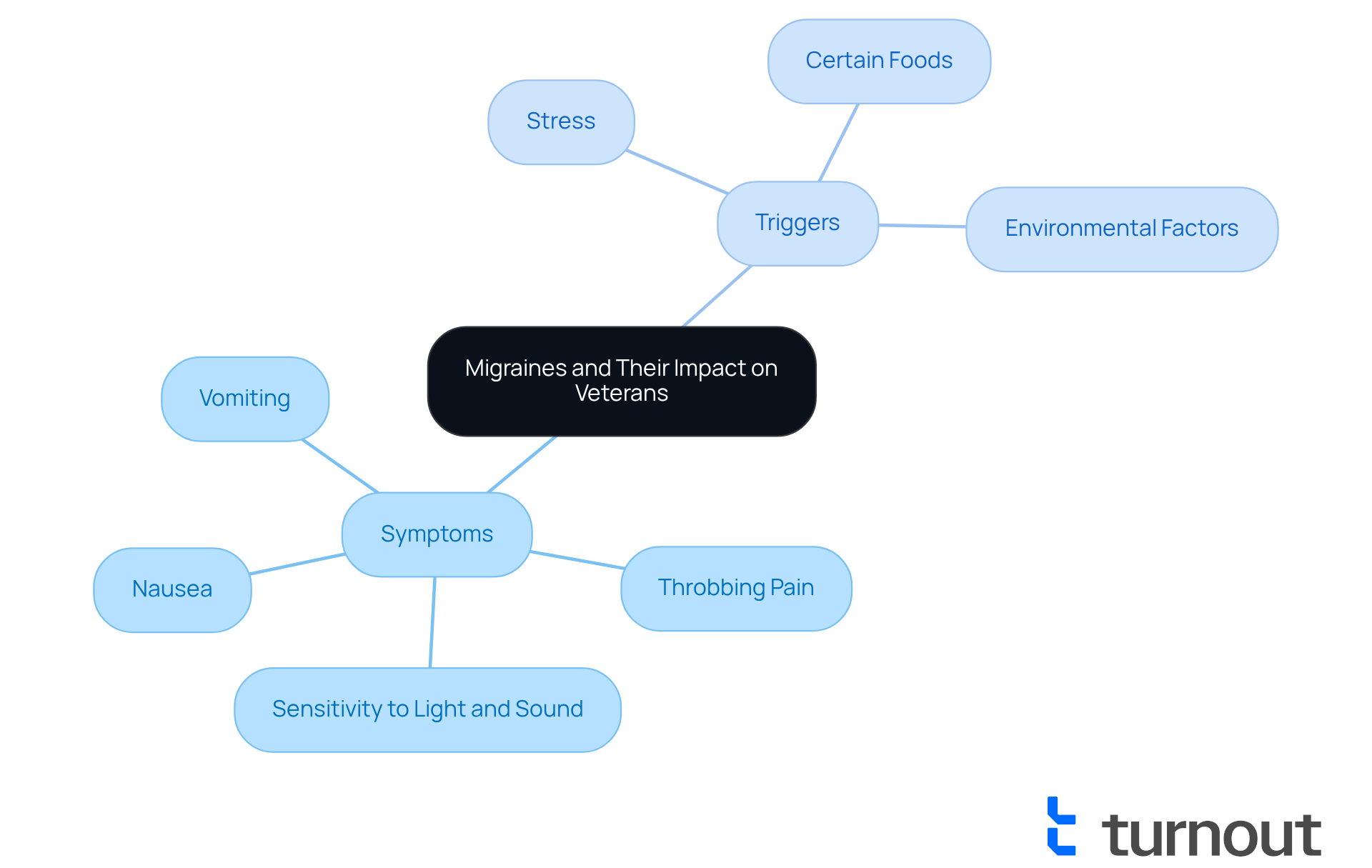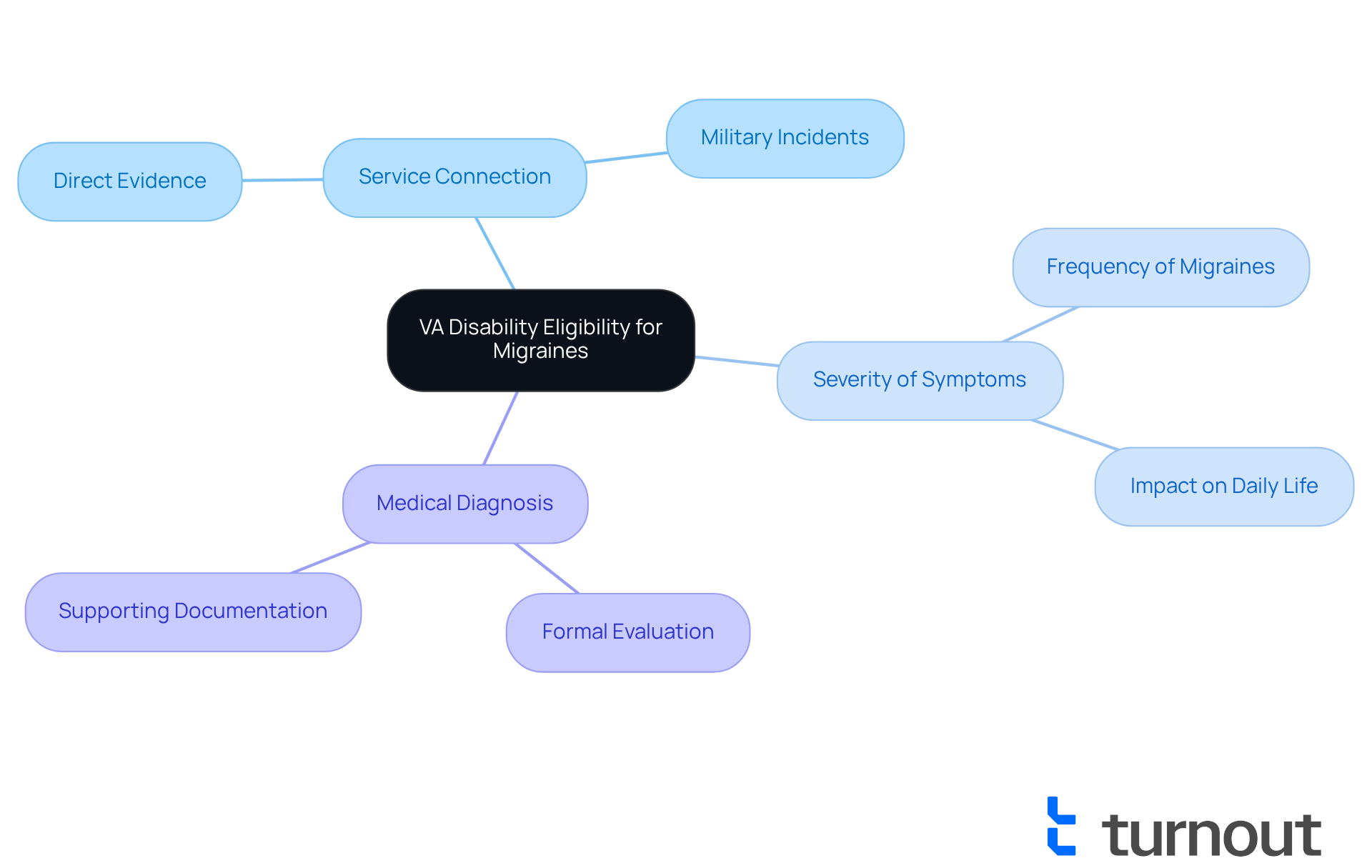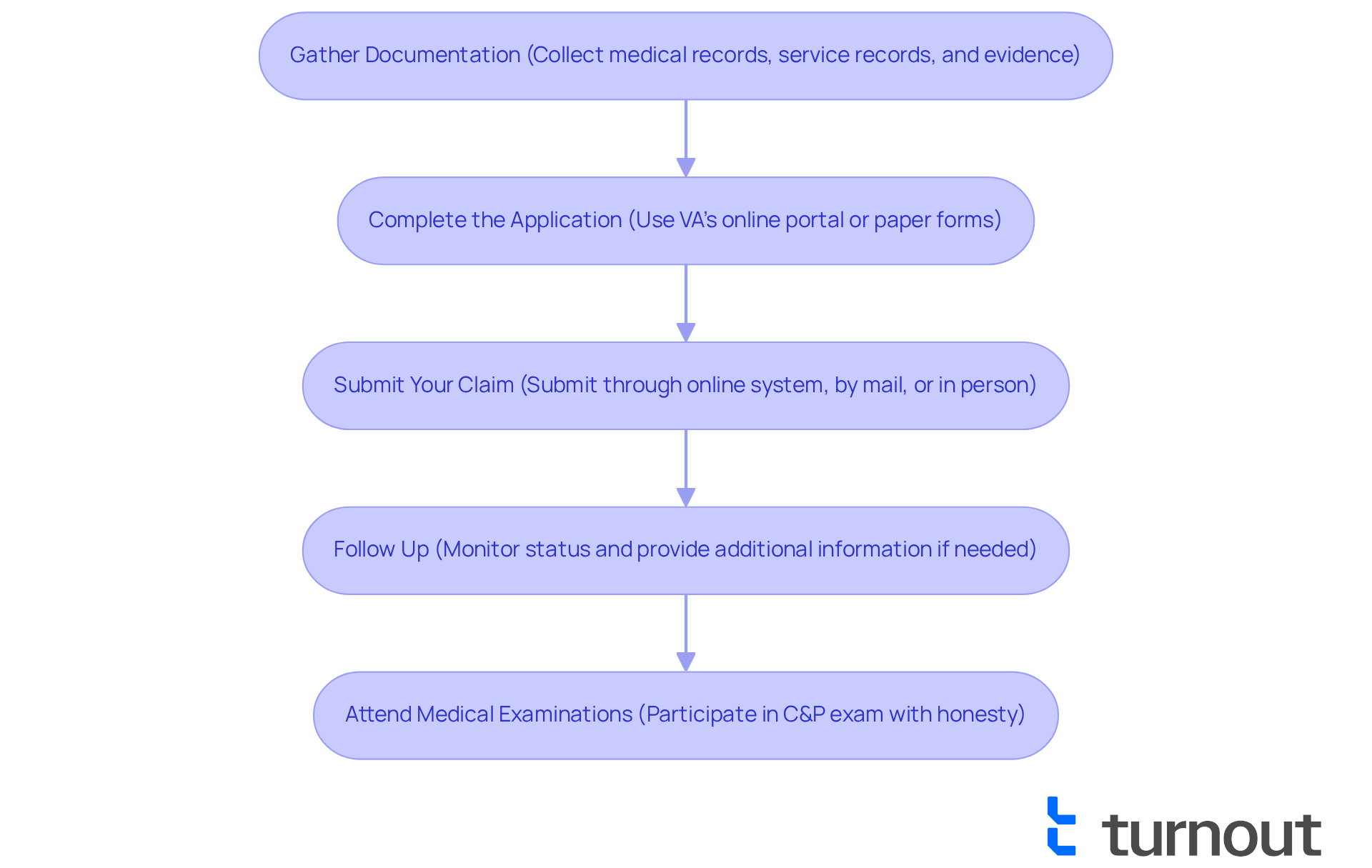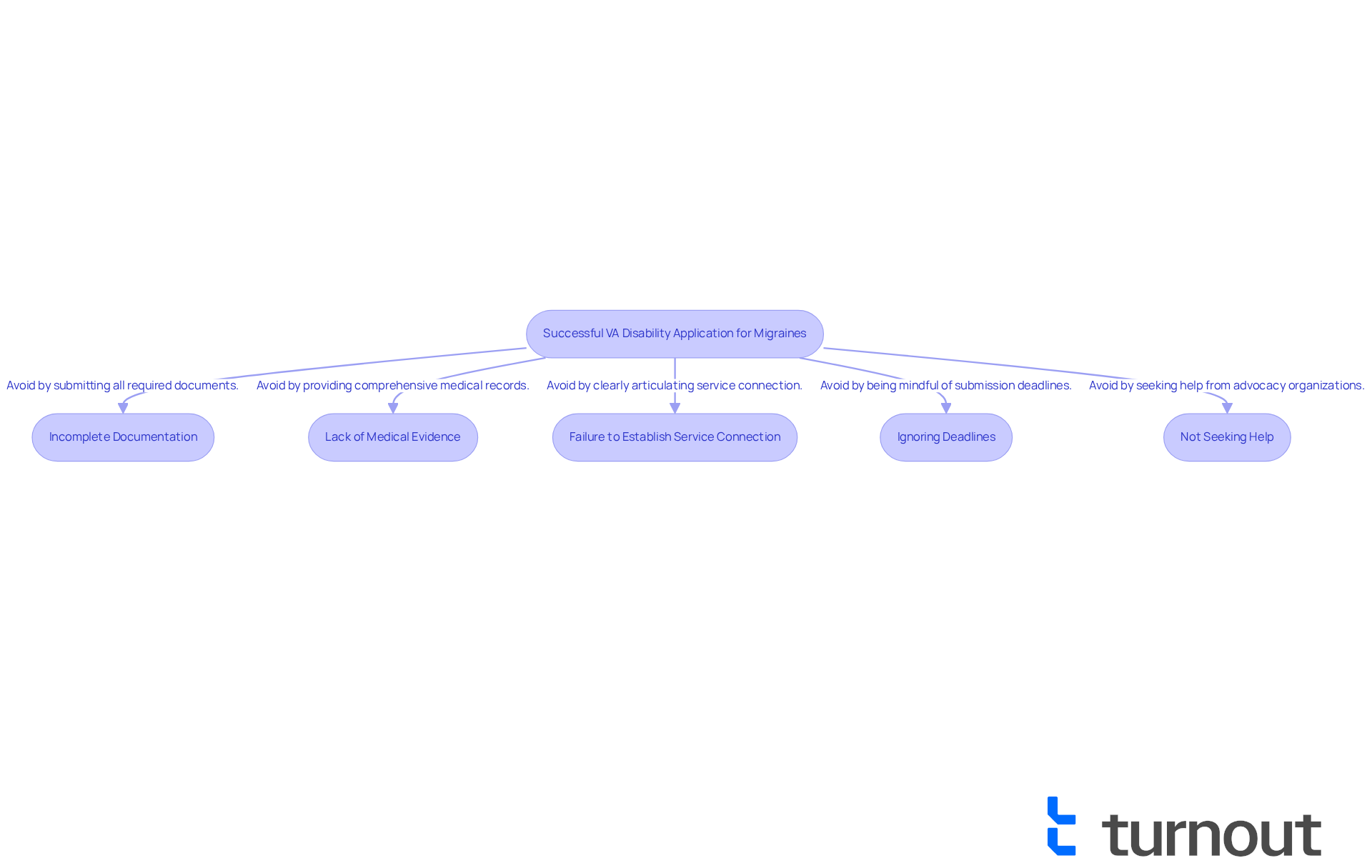Overview
This article serves as a compassionate guide for veterans navigating the VA disability process for migraines. We understand that this journey can be overwhelming, and it's essential to grasp the symptoms, eligibility criteria, and the claims process. By detailing crucial steps like gathering medical documentation, establishing a service connection, and avoiding common application mistakes, we aim to empower you in successfully obtaining the benefits you deserve.
We recognize the challenges you may face, and we’re here to help. Gathering the right medical documentation is vital; it supports your claim and illustrates the impact of migraines on your life. Establishing a service connection can feel daunting, but knowing that you are not alone in this journey can provide comfort.
Avoiding common application mistakes is another key aspect. Many veterans overlook simple details that can make a significant difference in their claims. Remember, it’s common to feel uncertain during this process, but with the right information and support, you can navigate it successfully.
Take these steps to heart, and know that we are here for you every step of the way. You have the strength to advocate for yourself, and the benefits you seek are within reach. Together, we can work towards ensuring you receive the support you need.
Introduction
Navigating the complexities of VA disability for migraines can feel overwhelming for veterans dealing with debilitating symptoms. These intense headaches can disrupt daily life significantly. Therefore, it is essential to understand the eligibility criteria and the claims process to secure the benefits you deserve.
What steps can you take to effectively communicate your experiences and avoid common pitfalls in your application?
We understand that this journey can be challenging, and this guide offers a comprehensive roadmap to help you advocate for your health and well-being amidst the difficulties posed by migraines.
Understand Migraines: Symptoms and Impact on Veterans
Migraines are more than just intense headaches; they can significantly impact your daily life. We understand that common symptoms, such as:
- Throbbing pain
- Sensitivity to light and sound
- Nausea
- Vomiting
can be overwhelming. For veterans, these challenges may lead to difficulties in maintaining employment, social interactions, and overall quality of life. Recognizing these symptoms is the first step in effectively conveying the impact of headaches when seeking VA disability for migraines benefits.
It's important to keep a detailed log of your headache episodes, noting their frequency, duration, and intensity. This information is essential in supporting your claims. Furthermore, identifying triggers that may worsen your headaches—such as:
- Stress
- Certain foods
- Environmental factors
can be incredibly beneficial. Understanding your triggers not only aids in managing your condition but also strengthens your case for VA disability for migraines, highlighting the debilitating nature of migraines.
Remember, you are not alone in this journey. We’re here to help you navigate these challenges and advocate for the support you deserve.

Determine Eligibility: VA Disability Criteria for Migraines
Navigating the process for VA disability for migraines can feel overwhelming, but understanding the requirements can help ease your journey. To be eligible, former military personnel must meet specific criteria set by the Department of Veterans Affairs. Here are the key factors to consider:
-
Service Connection: It’s important to show that your headaches are linked to your time in service. This connection can be established through direct evidence, such as medical records or incidents related to your military experience that may have triggered your condition.
-
Severity of Symptoms: The VA evaluates the severity of headaches based on their frequency and intensity. We encourage you to document how often you experience migraines and how they impact your daily life, especially for your VA disability for migraines. This information is vital in illustrating your situation.
-
Medical Diagnosis: A formal diagnosis from a healthcare provider is essential. Seeking an evaluation from a medical professional who can confirm your diagnosis and provide supporting documentation is a crucial step.
Gathering all relevant medical records, including your treatment history and any prescribed medications, will be invaluable in establishing your eligibility. Remember, you are not alone in this journey, and we’re here to help you every step of the way.

File Your Claim: Step-by-Step Process for VA Disability Benefits
Filing a claim for VA disability for migraines can feel overwhelming, but we're here to help you through it. Follow these key steps to ensure your claim is submitted accurately and effectively:
-
Gather Documentation: Start by collecting all necessary documents, such as medical records, service records, and any evidence that supports the connection between your military service and your headaches. This foundational step is crucial in building your case.
-
Complete the Application: Use the VA's online portal or paper forms to fill out your application. It's important to ensure that all sections are completed correctly, including your personal information, service history, and specific details regarding your headaches. Remember, attention to detail matters.
-
Submit Your Claim: Once your application is complete, submit it through the VA's online system, by mail, or in person at a regional office. Keeping copies of everything you submit is essential for your records, so don’t forget this step.
-
Follow Up: After submission, it’s common to feel anxious about the status of your request. Monitor it through the VA's website or by contacting their office. Be prepared to provide additional information if they ask for it; this is a normal part of the process.
-
Attend Medical Examinations: The VA may require you to attend a Compensation & Pension (C&P) exam to evaluate the severity of your headaches. Approach this appointment with honesty and provide detailed information about your condition. Your openness will help ensure an accurate assessment.
By following these steps, you can confidently navigate the process of obtaining VA disability for migraines. Remember, you are not alone in this journey, and support is available every step of the way.

Avoid Common Mistakes: Tips for a Successful Application
To enhance the likelihood of a successful VA disability claim for migraines, veterans should be aware of common mistakes and how to avoid them:
-
Incomplete Documentation: It's essential to ensure that all required documents are submitted. Missing information can postpone the process or result in rejection. In fact, 50% of VA requests are either rejected or deferred due to insufficient evidence.
-
Lack of Medical Evidence: Providing comprehensive medical records detailing the diagnosis and treatment of headaches is crucial. This includes notes from healthcare providers and any prescribed medications. Obtaining a diagnosis from a VA-approved healthcare provider is the initial step in the application process. Remember, robust medical evidence greatly enhances the likelihood of approval for VA disability for migraines.
-
Failure to Establish Service Connection: It's important to clearly articulate how military service is linked to the migraines for VA disability for migraines. This may require additional documentation or statements from fellow service members, which can corroborate the events leading to the condition.
-
Ignoring Deadlines: Be mindful of submission deadlines and check on the status of your request regularly. Veterans have one year to finalize and submit their VA application after filing a Notice of Intent to File. Delays can lead to missed opportunities for benefits.
-
Not Seeking Help: If the process feels overwhelming, consider reaching out to a consumer advocacy organization or knowledgeable professionals for assistance. Many former service members have effectively navigated the claims process by utilizing help from skilled advocates. Additionally, resources for former service members in crisis, such as confidential helplines, are available to provide further support.
By being aware of these common pitfalls and taking proactive steps to avoid them, veterans can significantly improve their chances of receiving the benefits they deserve. Remember, you are not alone in this journey, and we’re here to help.

Conclusion
Navigating the complexities of VA disability for migraines can feel overwhelming for veterans seeking the support they deserve. We understand the debilitating symptoms of migraines and the importance of establishing eligibility based on service connection and severity. Following the correct steps to file a claim is essential in securing benefits. Remember, you are not alone in this process; there are resources available to assist you every step of the way.
Key insights from this guide highlight the importance of:
- Documenting migraine episodes
- Gathering comprehensive medical evidence
- Avoiding common pitfalls that can hinder the claims process
By diligently collecting necessary documentation and clearly articulating the connection between military service and migraines, you can significantly enhance your chances of a successful claim. Additionally, seeking assistance from advocacy organizations can provide invaluable support as you navigate this often overwhelming journey.
Ultimately, pursuing VA disability benefits for migraines is a vital step toward improving your quality of life. It is imperative to take proactive measures, stay informed about eligibility criteria, and utilize available resources to ensure your voice is heard. By doing so, you can advocate for your health and well-being, paving the way for a brighter future. Remember, we’re here to help you through this journey.
Frequently Asked Questions
What are the common symptoms of migraines?
Common symptoms of migraines include throbbing pain, sensitivity to light and sound, nausea, and vomiting.
How can migraines affect veterans' daily lives?
Migraines can significantly impact veterans' daily lives by leading to difficulties in maintaining employment, social interactions, and overall quality of life.
Why is it important for veterans to recognize their migraine symptoms?
Recognizing migraine symptoms is crucial for effectively conveying the impact of headaches when seeking VA disability benefits for migraines.
What should veterans do to support their claims for VA disability for migraines?
Veterans should keep a detailed log of their headache episodes, noting the frequency, duration, and intensity, as this information is essential in supporting their claims.
What are some common triggers that can worsen migraines?
Common triggers that may worsen migraines include stress, certain foods, and environmental factors.
How can understanding migraine triggers help veterans?
Understanding migraine triggers can aid in managing the condition and strengthen the case for VA disability benefits by highlighting the debilitating nature of migraines.
Is there support available for veterans dealing with migraines?
Yes, there is support available for veterans, and they are encouraged to seek help in navigating the challenges associated with migraines and advocating for the support they deserve.




